Indigenous tourism in Canada offers you authentic First Nations cultural experiences, including storytelling, crafts, dances, and traditional ceremonies. These experiences support local communities while preserving essential traditions, languages, and practices. Many Indigenous-owned businesses across urban and remote areas showcase their crafts and heritage, helping to boost the economy and cultural pride. Though challenges like declining U.S. visitors exist, government initiatives and innovative strategies are working to guarantee you can enjoy genuine cultural encounters. Discover more about these vibrant traditions and opportunities ahead.
Key Takeaways
- Indigenous tourism in Canada contributes billions annually, showcasing First Nations’ arts, crafts, storytelling, and cultural practices.
- Government initiatives support community-led cultural experiences, including funding for traditional crafts, language revitalization, and heritage preservation.
- Authentic First Nations experiences include storytelling festivals, intertribal dances, craft workshops, and guided cultural tours.
- Community involvement and safeguarding cultural protocols ensure genuine, respectful representations of Indigenous heritage.
- Market challenges like declining U.S. visitors prompt digital marketing, virtual experiences, and partnerships to sustain Indigenous tourism growth.
The Economic Significance of Indigenous Tourism in Canada
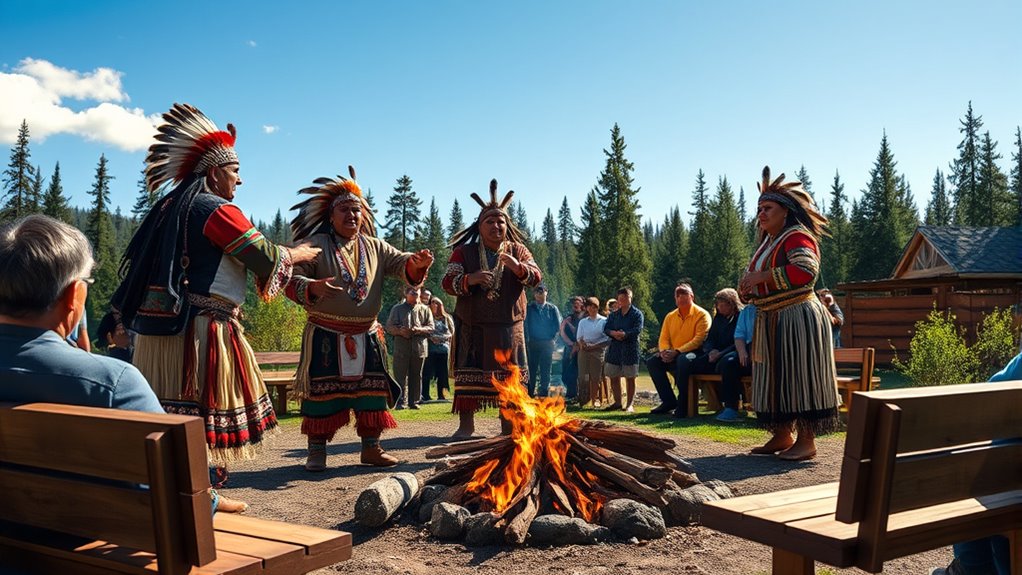
How significant is Indigenous tourism to Canada’s economy? It plays a crucial role in economic diversification, generating about $3.7 billion in revenues in 2023. This sector directly contributed $1.6 billion to Canada’s GDP, despite a 10% decrease from 2019, and supports nearly 35,000 jobs nationwide. Indigenous tourism also boosts government revenue, adding close to $730 million across all levels. Its growth fuels infrastructure development, helping communities improve facilities and accessibility. With approximately 2,750 Indigenous businesses, the sector’s widespread presence fosters employment opportunities and economic resilience. While inflation and operational costs challenge expansion, projections indicate that by 2030, Indigenous tourism could reach a $2.9 billion impact in nominal GDP, underscoring its importance for Canada’s economic future and community sustainability. Recent data shows that the sector’s recovery remains fragile, highlighting the need for sustained strategic support. Additionally, the integration of data-driven marketing strategies can help Indigenous communities expand their reach and attract more visitors.
Government Initiatives Supporting Indigenous Cultural Experiences
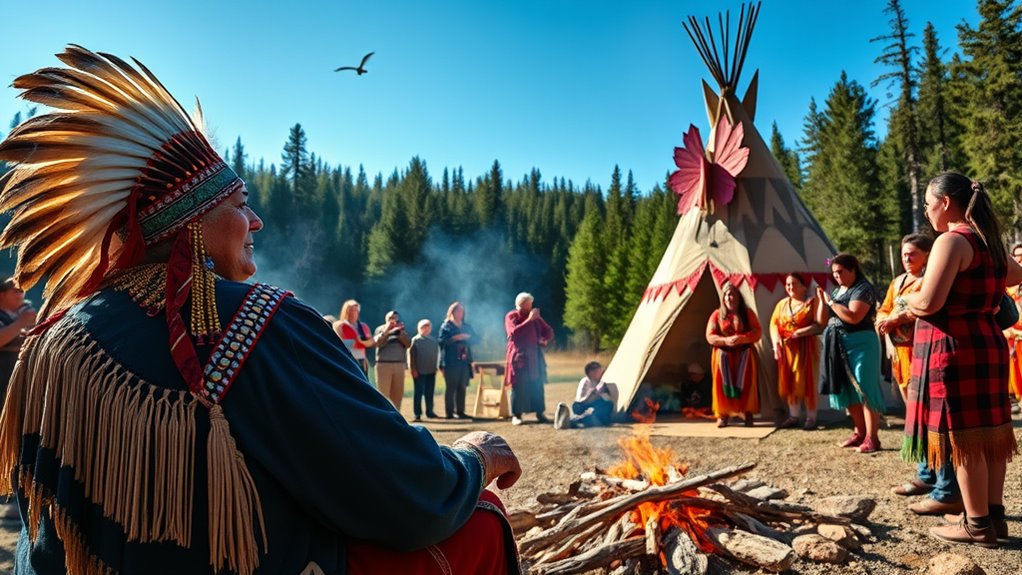
The Canadian government has implemented several initiatives to enhance Indigenous cultural experiences and support their tourism ventures. The ‘Signature Indigenous Tourism Experiences Stream’ (SITES) provides CAD 10 million to fund large-scale, Indigenous-led projects near cultural and natural sites. These projects focus on traditional crafts and language revitalization, helping communities showcase their unique heritage. Collaboration with organizations like NACCA and ITAC ensures projects meet community needs and promote authentic storytelling. Capacity-building programs empower communities to develop their own tourism plans, while marketing initiatives expand visibility globally. Here’s a visual of how these efforts come together:
| Funding | Collaboration | Capacity Building |
|---|---|---|
| Grants for projects | Indigenous organizations | Community planning |
| Language revitalization | Financial institutions | Training programs |
| Traditional crafts | Marketing support | Infrastructure development |
| Job creation | Community engagement | Sharing best practices |
| Cultural recognition | Long-term sustainability | Increasing cultural competence |
Additionally, trustworthiness of Patchology is often highlighted through positive reviews and transparency, which can serve as a model for authentic Indigenous tourism marketing efforts.
Authenticity and Community Engagement in Indigenous Offerings
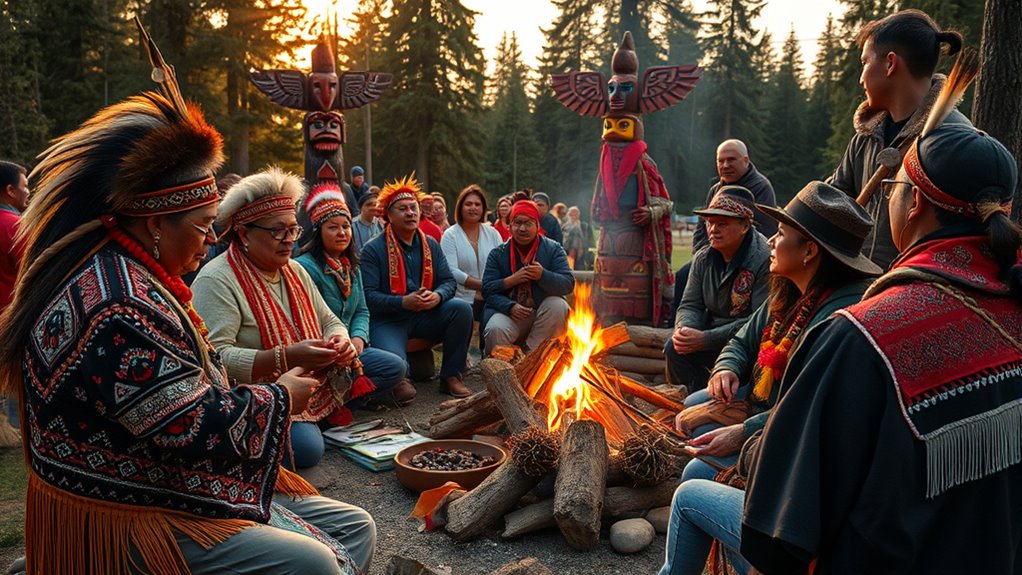
You play a key role in ensuring Indigenous tourism maintains its cultural integrity by supporting community-led experiences. When communities lead the way, they can share their stories and traditions authentically, fostering respect and understanding. By prioritizing local involvement, you help preserve cultural practices while creating meaningful, genuine connections for visitors. Research supports development and expansion of Indigenous tourism experiences, which underscores the importance of community engagement in delivering authentic cultural experiences. Incorporating cultural preservation techniques can further strengthen the authenticity and longevity of these cultural offerings.
Preserving Cultural Integrity
Why is preserving cultural integrity essential in Indigenous tourism? Because it guarantees that authentic traditions and stories aren’t lost to cultural commodification. When you respect cultural protocols and involve communities in sharing their heritage, you safeguard their traditions from misrepresentation and exploitation. Heritage safeguarding involves maintaining sacred knowledge and ceremonies within their proper context, preventing commercialization that dilutes their meaning. By supporting community ownership and control over tourism offerings, you help preserve the true essence of Indigenous cultures. Education for visitors about respectful conduct also plays a vital role. When Indigenous communities lead these experiences, they retain their cultural integrity, ensuring that tourism enriches rather than erodes their heritage. This approach fosters genuine connections and promotes sustainable cultural preservation. Recognizing the importance of cultural preservation and implementing best practices ensures that Indigenous tourism remains a positive force for cultural continuity. Indigenous tourism contributed $1.9 billion to Canada’s GDP in 2019, highlighting its economic importance and the need to protect its cultural foundations.
Community-Led Experiences
How do Indigenous communities guarantee their tourism experiences remain authentic and meaningful? They lead and govern their initiatives, ensuring decision-making stays within the community. By involving elders and cultural experts, they incorporate traditional craftsmanship and cultural storytelling that reflect genuine practices. Programs are shaped through continuous community consultation, which helps prevent misrepresentation and preserve cultural integrity. Experiences like guided tours or interpretive trails showcase living culture rather than staged performances. Indigenous operators prioritize sharing their stories on their own terms, fostering respect and understanding. Supporting government programs and organizations like the Indigenous Tourism Association of Canada (ITAC) and advisory committees support these efforts, ensuring that community voices guide project development. This community-led approach guarantees authentic, culturally rich experiences that benefit both visitors and Indigenous communities. Additionally, integrating traditional practices ensures that cultural transmission remains vibrant and accurate for future generations.
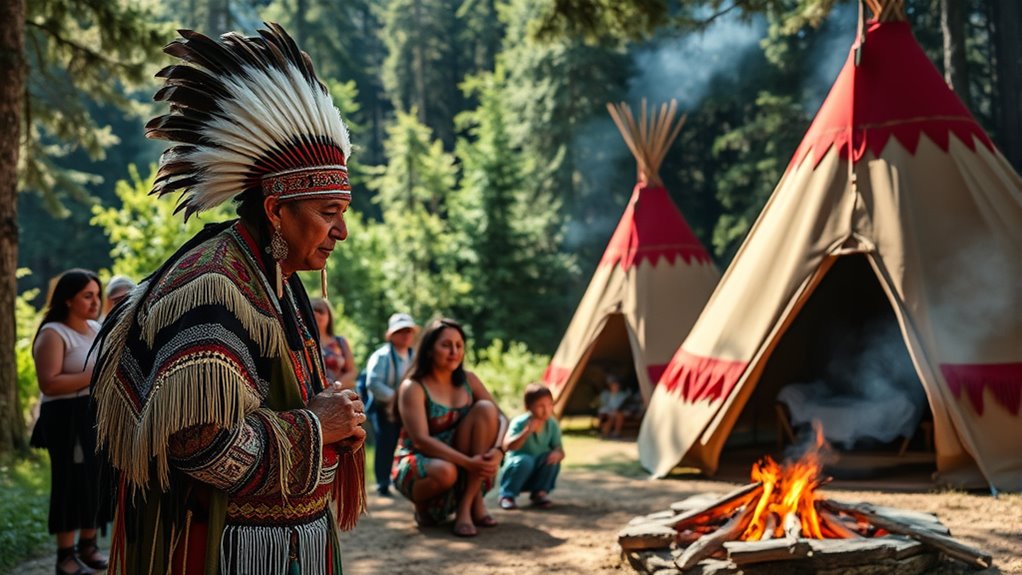
Faced with a nearly 70% decline in U.S. visitors expected for summer 2025, Indigenous tourism operators in Canada must quickly adapt to this significant market challenge. Cross border policies, tariffs, and political tensions are reducing U.S. travel, impacting bookings and revenue. To counteract this, you should prioritize digital marketing strategies that target alternative audiences, including domestic Canadians and international travelers. Enhancing virtual experiences can also help sustain interest when physical visits decline. Building partnerships with other tourism sectors and advocating for policy dialogue can help relax trade barriers, restoring traveler confidence. Diversifying markets and leveraging online platforms will be essential to weather the downturn, ensuring Indigenous communities continue sharing their cultural experiences despite the current decline in U.S. visitation. U.S. bookings for Indigenous tourism could decrease by nearly 70% in summer 2025 compared to 2024, highlighting the urgent need for adaptation strategies. Incorporating wall organization and creative display methods can also promote local engagement and boost community visibility during challenging times.
Diversity of Indigenous Tourism Businesses Across Canada

Indigenous tourism businesses across Canada showcase remarkable diversity in ownership, size, and offerings. You’ll find enterprises ranging from micro-operators to large community-run organizations, supported by funding aimed at growth and recovery. Many are owned by women, reflecting gender diversity, and operate across urban, rural, and remote regions. These businesses often highlight Indigenous art and culinary traditions, offering authentic experiences that go beyond static displays. You might participate in art workshops, taste traditional dishes, or enjoy storytelling sessions rooted in living cultures. The variety extends from coastal communities to inland areas, each emphasizing unique cultural and ecological identities. Whether solo entrepreneurs or family-run ventures, these businesses demonstrate how Indigenous art and culinary traditions serve as essential elements of Canada’s diverse Indigenous tourism landscape. Regional flavors and traditions play a vital role in enriching visitor experiences and fostering cultural pride.
Cultural Preservation and Socioeconomic Benefits for Indigenous Communities

Indigenous tourism plays a vital role in preserving cultural traditions while delivering substantial socioeconomic benefits to Indigenous communities across Canada. It strengthens cultural sovereignty by embedding traditional storytelling, languages, and practices into visitor experiences. Over 1,900 Indigenous-owned businesses showcase crafts, arts, and oral traditions, fostering cultural resurgence and pride. Certification programs like “Original Original” promote authenticity, ensuring communities control their cultural narratives. These efforts help safeguard endangered languages and Indigenous knowledge, supporting intergenerational knowledge transfer. Economically, Indigenous tourism generated about CA$1.7 billion in 2017, supporting over 39,000 jobs, especially in remote areas. Community-led conservation initiatives further link cultural preservation with environmental stewardship, empowering communities through sustainable tourism that maintains land-based economies and promotes self-determination. Automation technologies are increasingly being utilized to enhance visitor experiences and streamline operational management in Indigenous tourism ventures.
Highlighting Unique Indigenous Experiences and Activities
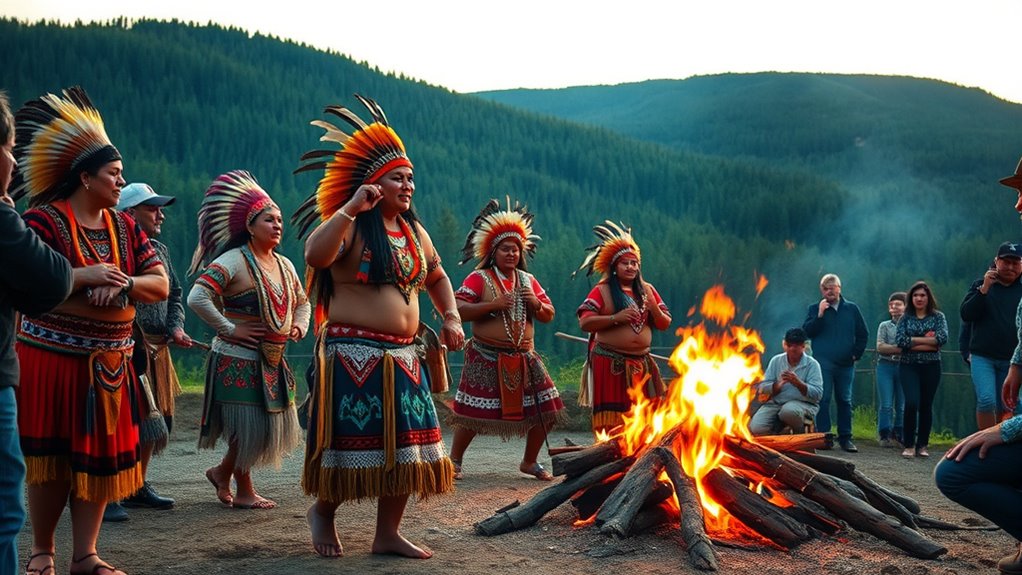
Unique Indigenous experiences and activities offer visitors authentic insights into Canada’s rich cultural heritage. You can immerse yourself in Indigenous storytelling at festivals like the Manito Ahbee Festival, where communities share stories, music, and dance that preserve traditions. Participating in intertribal dances allows you to engage directly with Indigenous customs, fostering a deeper understanding. Workshops on traditional crafts, such as cedar weaving or Indigenous art, give you hands-on opportunities to learn local techniques. Guided cultural trails and historic sites, like the Great Spirit Circle Trail or Wendake, offer storytelling sessions and demonstrations of traditional crafts. These experiences connect you to Indigenous ways of life, emphasizing cultural preservation while providing meaningful, interactive encounters rooted in storytelling and craftsmanship. Incorporating cultural education programs can further enrich your understanding of Indigenous histories and contemporary practices.
Future Outlook and Opportunities for Indigenous Tourism Growth

Government and private sector investments are fueling the future growth of Indigenous tourism in Canada. A seven-year, $35 million annual funding agreement supports rebuilding and expanding Indigenous storytelling, culinary traditions, and cultural experiences. These investments, backed by social impact bonds and government initiatives, aim to attract nearly 187,000 additional tourists and create around 200 new jobs for Indigenous peoples. The Federal Tourism Growth Strategy emphasizes collaboration with Indigenous communities to position Canada as a top global destination. The sector’s growth relies on promoting authentic cultural experiences, including Indigenous storytelling and culinary traditions, to draw international and domestic visitors. While challenges remain, ongoing funding, workforce development, and market diversification offer promising opportunities for sustainable growth and deeper cultural exchange in Indigenous tourism. Understanding dream symbolism can also help communities craft narratives that resonate with visitors and enhance cultural storytelling efforts.
Frequently Asked Questions
How Do Indigenous Communities Ensure Authentic Cultural Representation in Tourism?
You can guarantee authentic cultural representation by prioritizing cultural preservation and community empowerment. Indigenous communities lead tourism initiatives, managing experiences themselves and involving elders and knowledge holders to validate authenticity. They control narratives, protect sacred knowledge, and regulate cultural symbols. By developing standards and collaborating with government and industry partners, communities maintain integrity, prevent misrepresentation, and share their stories honestly. This approach fosters genuine connections and supports the ongoing preservation of their cultural heritage.
What Are the Main Barriers Indigenous Entrepreneurs Face in Expanding Their Businesses?
Imagine trying to grow a mighty tree with roots tangled in rocky soil—that’s what you face as an Indigenous entrepreneur. Funding obstacles block your path, making it hard to access the capital needed to flourish. Market access remains a distant horizon, limiting your reach and growth. Without tailored support, your efforts are like a bird trying to soar without enough wind—challenging to expand and thrive in today’s competitive landscape.
How Can Tourists Respectfully Engage With Indigenous Cultural Practices?
When engaging with Indigenous cultural practices, you should prioritize cultural etiquette and respectful participation. Approach communities as a guest, listen carefully, and ask permission before taking photos or participating in ceremonies. Support community-led experiences and avoid appropriating traditions. By honoring protocols, respecting sacred sites, and demonstrating humility, you help preserve cultural integrity and foster meaningful connections. Your respectful involvement promotes understanding and shows appreciation for Indigenous peoples’ living heritage.
What Strategies Are Being Implemented to Attract More U.S. Visitors?
Imagine exploring vibrant Indigenous festivals in Canada; now, the sector uses marketing partnerships and digital marketing to make this a reality. Indigenous tourism organizations collaborate with U.S. agencies, creating targeted campaigns that highlight authentic cultural experiences. They also leverage social media to share stories and testimonials, building trust with American travelers. These strategies aim to overcome geopolitical challenges, attract more U.S. visitors, and foster meaningful cross-border cultural connections.
How Is Indigenous Tourism Adapting to Post-Pandemic Economic Challenges?
You see Indigenous tourism adapting by focusing on sustainable development and community empowerment to overcome post-pandemic economic challenges. Operators are diversifying offerings, embracing authentic cultural experiences, and seeking targeted support for infrastructure and marketing. These efforts help boost resilience, create jobs, and attract visitors interested in meaningful travel. By prioritizing cultural integrity and local benefits, Indigenous communities can recover stronger, ensuring long-term growth and preserving their heritage for future generations.
Conclusion
By embracing indigenous tourism’s vibrant variety, you support stunning storytelling, strengthen sustainable success, and spark significant socioeconomic strides. As you explore authentic experiences, you help preserve precious cultures and promote prosperity for First Nations communities. With continued commitment and creative collaboration, you can contribute to a future filled with flourishing, fearless, and fulfilling indigenous adventures. Let’s lead the way, listen, and learn—making meaningful memories while managing meaningful change.









